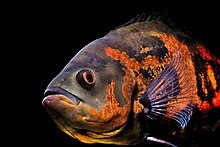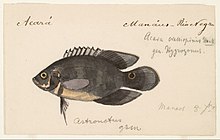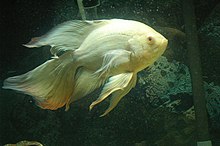
Cichlids are fish from the family Cichlidae in the order Cichliformes. Traditionally Cichlids were classed in a suborder, the Labroidei, along with the wrasses (Labridae), in the order Perciformes, but molecular studies have contradicted this grouping. On the basis of fossil evidence, it first appeared in Tanzania during the Eocene epoch, about 46–45 million years ago; however, molecular clock estimates have placed the family's origin as far back as 67 million years ago, during the late Cretaceous period. The closest living relative of cichlids is probably the convict blenny, and both families are classified in the 5th edition of Fishes of the World as the two families in the Cichliformes, part of the subseries Ovalentaria. This family is large, diverse, and widely dispersed. At least 1,650 species have been scientifically described, making it one of the largest vertebrate families. New species are discovered annually, and many species remain undescribed. The actual number of species is therefore unknown, with estimates varying between 2,000 and 3,000.
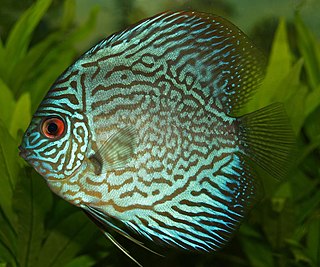
Symphysodon is a genus of cichlids native to the Amazon river basin in Brazil. Due to their distinctive shape, calm behavior, many bright colors and patterns, and dedicated parenting techniques, discus are popular as freshwater aquarium fish, and their aquaculture in several countries in Asia is a major industry. They are sometimes referred to as pompadour fish. The discus fish has attracted a cult following of collectors and has created a multimillion dollar international industry complete with shows, competitions, and reputable online breeders.

The tinfoil barb is a tropical Southeast Asian freshwater fish of the family Cyprinidae. This species was originally described as Barbus schwanenfeldii by Pieter Bleeker in 1853, and has also been placed in the genera Barbodes and Puntius. The specific epithet is frequently misspelled schwanefeldii.

Painted fish are ornamental aquarium fish which have been artificially coloured to appeal to consumers. This artificial colouring, also known as juicing, is achieved by a number of methods, such as injecting the fish with a hypodermic syringe containing bright fluorescent colour dye, dipping the fish into a dye solution, or feeding the fish dyed food.

The firemouth cichlid is a species of cichlid fish native to Central America. They occur in rivers of the Yucatán Peninsula, Mexico, south through Belize and into northern Guatemala.

Parachromis managuensis is a large species of cichlid native to freshwater habitats in Central America, where it is found from Honduras to Costa Rica. The binomial name refers to Lake Managua in Nicaragua, from which the holotype was obtained. It is a food fish and is also found in the aquarium trade where it is variously known as the jaguar cichlid, managuense cichlid, managua cichlid, guapote tigre, Aztec cichlid, spotted guapote and jaguar guapote. In Costa Rica, it is known as the guapote tigre.
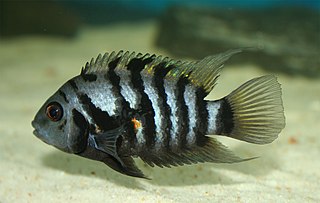
The convict cichlid is a fish species from the family Cichlidae, native to Central America, also known as the zebra cichlid. Convict cichlids are popular aquarium fish and have also been the subject of numerous studies on fish behaviour.

The ram cichlid is a species of freshwater fish endemic to the Orinoco River basin, in the savannahs of Venezuela and Colombia in South America. The species has been examined in studies on fish behaviour and is a popular aquarium fish, traded under a variety of common names, including ram, blue ram, German blue ram, Asian ram, butterfly cichlid, Ramirez's dwarf cichlid, dwarf butterfly cichlid and Ramirezi. The species is a member of the family Cichlidae and subfamily Geophaginae.

Astronotus is a genus of South American fish from the family Cichlidae. There are two commonly recognized species in the genus, though genetic evidence suggests that additional species exist; several of these possibly distinct populations also have very different juvenile coloration from the two recognized species. Both of the commonly recognized species are found in the Amazon Basin, while one of two also is found in the Paraná and Paraguay rivers. Astronotus species grow to 35 cm in size, and are monomorphic. They are opportunistic omnivores and consume a range of smaller fish, fruits, nuts, crustaceans, mollusks and other invertebrates in the wild.

The keyhole cichlid is a cichlid fish endemic to tropical South America, occurring in the lower Orinoco Basin in Venezuela and river basins in The Guianas. It is the only species in the genus Cleithracara. The species is popular with fishkeeping hobbyists and is frequently kept in aquariums.
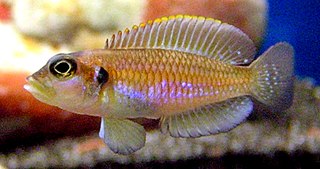
Lamprologus ocellatus is a species of shell dwelling cichlid endemic to Lake Tanganyika. It is a popular aquarium fish due to its small size, appearance, and intelligence.

Pelvicachromis pulcher is a freshwater fish of the cichlid family, endemic to Nigeria and Cameroon. It is popular amongst aquarium hobbyists, and is most commonly sold under the name kribensis, although it has other common names, including various derivatives and color morphs of the kribensis: krib, common krib, red krib, super-red krib and rainbow krib, along with rainbow cichlid and purple cichlid.

Mikrogeophagus altispinosus is a species of fish endemic to the southern Amazon River basin in Brazil and Bolivia. The species is part of the family Cichlidae and subfamily Geophaginae. It is a popular aquarium fish, traded under the common names Bolivian butterfly, Bolivian ram, Bolivian ram cichlid, and ruby crown cichlid.

Laetacara is a small genus of cichlids native to freshwater habitats in tropical and subtropical South America, ranging from the upper Orinoco River basin in Venezuela to the Paraná River basin Argentina. The genus is also collectively known as the smiling acaras. Like all cichlids, Laetacara species have well-developed brood care.

Mesonauta, the flag cichlids, is a small genus of cichlids native to the Amazon, Orinoco, Essequibo, Paraná and Paraguay basins in South America. Mesonauta is included in the subfamily Cichlasomatinae. They occur in various freshwater habitats such as streams and lakes, especially in areas with little water movement and aquatic vegetation. They are generally found in small groups that stay near the water surface. To avoid predators, adults may jump out of the water and juveniles mimic leaves.

Copadichromis borleyi is a species of haplochromine cichlid fish endemic to Lake Malawi in East Africa. The species is popular in the fishkeeping hobby where it is frequently kept in aquariums. The species has numerous common names, including redfin hap and goldfin hap.

Apistogramma nijsseni is a species of cichlid fish, endemic to highly restricted local black water habitats in the Quebrada Carahuayte, a small stream in the Ucayali River drainage, southern Peru. The male reaches a maximum length of 8 cm (3 in), the female remaining somewhat smaller. Apistogramma brooding females assume a bright yellow and black aposematic coloring: in A. nijsseni, unusually, a healthy, unstressed female retains this coloring. The species is popular aquarium fish amongst dwarf cichlid hobbyists, though it does not often appear in the general pet fish market.
Parachromis motaguensis, the false yellowjacket cichlid, is a species of cichlid native to Central America, where it can be found in Guatemala, El Salvador, and Honduras. This species grows to a length of 30 centimetres (12 in) TL. This species is farmed.

The blue acara is a colorful freshwater fish in the cichlid family. This fish can be found in various freshwater habitats, ranging from standing water to flowing streams, in Venezuela and Trinidad. They can reach lengths of 16 cm (6.3 in). The scientific species name is indicative to its looks; pulcher meaning "beautiful" in Latin. The blue acara is a common cichlid sold in many aquarium stores, and is sometimes confused with the larger green terror.

Mesonauta acora is a species of cichlid fish endemic to the Amazon Basin of Brazil; specifically, to blackwater in the Xingu and Tocantins River basins in South America. The species was named by François Louis de la Porte, comte de Castelnau in 1855.
